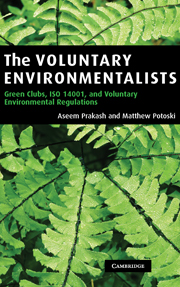Book contents
- Frontmatter
- Contents
- List of figures
- List of tables
- Preface
- Acknowledgements
- 1 Introduction
- 2 Green clubs: an institutionalist perspective
- 3 ISO 14001 and voluntary programs
- 4 Adopting ISO 14001
- 5 ISO 14001 and firms' environmental and regulatory performance
- 6 Conclusions and future directions
- References
- Name Index
- Subject Index
3 - ISO 14001 and voluntary programs
Published online by Cambridge University Press: 10 December 2009
- Frontmatter
- Contents
- List of figures
- List of tables
- Preface
- Acknowledgements
- 1 Introduction
- 2 Green clubs: an institutionalist perspective
- 3 ISO 14001 and voluntary programs
- 4 Adopting ISO 14001
- 5 ISO 14001 and firms' environmental and regulatory performance
- 6 Conclusions and future directions
- References
- Name Index
- Subject Index
Summary
Chapter 2 laid out a framework for a theoretical analysis of voluntary environmental programs based on club theory. Indeed, we include “Green Clubs” in the title of this book to emphasize their prominence in environmental governance debates. Dating back to the late 1980s, there has been a steadily growing interest in voluntary environmental programs among businesses, industry associations, regulators and even some environmental groups (Gibson, 1999). Many of these newer programs seek to establish common management standards and/or outcome goals among companies within or across industries. However, voluntary regulatory programs that seek to influence firms' activities have been around for a long time and have not been confined to environmental issues. Webb (2004: 2) notes the following:
For thousands of years, merchant behaviour has been controlled through non-governmental techniques. In the Middle Ages in Europe (and much earlier elsewhere), merchant guilds regulated virtually every aspect of a given commercial activity, from market access through means of production, product quality and price, enforcement of contracts, and even an element of welfare protection for guild members and their families. While guilds have faded in importance with the rise of the State, private regulatory techniques which use non-governmental intermediaries to ensure compliance have continued to flourish, against a backdrop of law: the Better Business Bureau, for example, had its origins in merchant “vigilance committees” first created in the late 1800s, the International Chamber of Commerce first published its Code of Advertising Practice in 1937, and many other forms of industry self-regulation were put in place throughout the twentieth century.
- Type
- Chapter
- Information
- The Voluntary EnvironmentalistsGreen Clubs, ISO 14001, and Voluntary Environmental Regulations, pp. 81 - 101Publisher: Cambridge University PressPrint publication year: 2006



